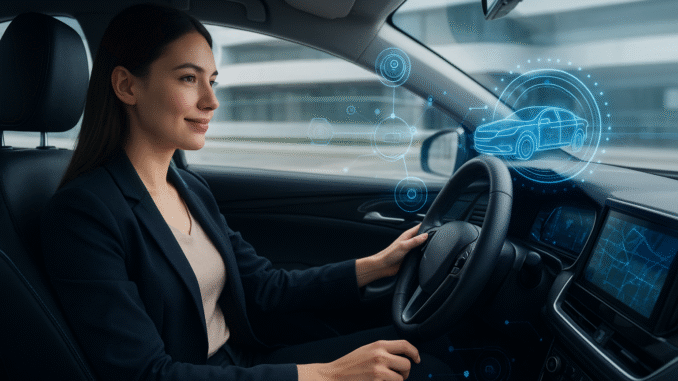
Smart Cars and AI: The Next Big Revolution in Automotive Technology
The automotive industry is undergoing a transformation unlike any it has ever experienced before. From the invention of the internal combustion engine to the rise of electric vehicles, each innovation has changed the way we drive and think about transportation. But today, a new revolution is underway—one driven by artificial intelligence (AI). Smart cars powered by AI are redefining not only how we drive but also how cars interact with us, the road, and the world around them.
Artificial intelligence is the brain behind this new generation of vehicles. It allows cars to “think,” “learn,” and “adapt” to real-world conditions, making driving safer, more efficient, and more connected. Let’s explore how AI is transforming the automotive industry and shaping the future of smart mobility.
1. The Rise of Smart Cars: A New Era of Mobility
Smart cars are no longer science fiction—they are a growing reality on our roads. These vehicles use advanced sensors, cameras, machine learning algorithms, and data analytics to interpret their surroundings and make real-time decisions. Unlike traditional cars that rely solely on human drivers, smart cars can assist—or even replace—humans in controlling the vehicle.
The global market for smart and connected cars is expanding rapidly. According to industry reports, the smart car market is projected to exceed $600 billion by 2030, fueled by the integration of AI, Internet of Things (IoT), and 5G connectivity. Automakers like Tesla, BMW, Mercedes-Benz, and Waymo are leading this revolution, developing cars that can navigate complex environments, communicate with other vehicles, and continuously improve their performance through software updates.
2. Artificial Intelligence: The Brain Behind the Wheel
Artificial intelligence is the driving force behind smart car technology. AI enables vehicles to process massive amounts of data from various sources—cameras, LiDAR, radar, and GPS—to make split-second decisions. Let’s break down how AI powers different aspects of modern vehicles.
a. Perception and Awareness
AI allows smart cars to “see” the world around them. Using sensors and cameras, these systems detect pedestrians, other vehicles, traffic lights, and obstacles. Deep learning algorithms interpret this data to understand the environment and predict the behavior of other road users.
b. Decision-Making
Once the car understands its surroundings, AI algorithms decide what actions to take. For example, if a pedestrian suddenly crosses the road, the AI system instantly applies the brakes or swerves to avoid a collision. This decision-making process happens in milliseconds, far faster than a human driver’s reaction time.
c. Continuous Learning
One of the most exciting aspects of AI is its ability to learn. Through machine learning, cars continuously improve their performance based on driving data. Every trip helps the system refine its understanding of different road conditions, driver behaviors, and environmental factors.
This means that as more smart cars hit the road, the collective knowledge of the AI network grows—making every vehicle smarter and safer over time.
3. Autonomous Driving: The Future of AI-Powered Vehicles
Perhaps the most visible and revolutionary impact of AI in the automotive industry is autonomous driving. The dream of self-driving cars is quickly becoming a reality, with companies like Tesla, Waymo, and Cruise already testing autonomous vehicles on public roads.
Autonomous driving is often classified into five levels, ranging from simple driver assistance to full automation:
- Level 1: Basic assistance, such as cruise control or lane-keeping.
- Level 2: Partial automation—cars can steer, accelerate, and brake under certain conditions.
- Level 3: Conditional automation—cars can drive themselves but still require human supervision.
- Level 4: High automation—cars can operate independently in most situations.
- Level 5: Full automation—no human driver required at all.
While we’re still transitioning between Levels 3 and 4, the progress is accelerating rapidly. AI is essential in achieving these levels, as it enables the complex perception, prediction, and decision-making required for safe autonomous driving.
4. AI and Vehicle Safety: Saving Lives on the Road
Safety is one of the greatest benefits of AI in cars. Human error causes over 90% of traffic accidents, but AI-driven systems can significantly reduce this number. Smart cars use Advanced Driver Assistance Systems (ADAS), powered by AI, to prevent collisions and protect drivers and passengers.
Some of the most common AI-powered safety features include:
- Automatic Emergency Braking (AEB) – detects obstacles and stops the car automatically.
- Lane Departure Warning (LDW) – alerts drivers if they unintentionally drift out of their lane.
- Blind Spot Detection – monitors areas that human drivers can’t easily see.
- Driver Monitoring Systems – track eye movements and alertness to prevent drowsy driving.
- Pedestrian and Cyclist Detection – recognizes vulnerable road users and reacts instantly.
As these features become standard in vehicles, we can expect fewer accidents, fewer fatalities, and safer roads for everyone.
5. Smart Connectivity: The Internet of Cars
AI doesn’t just make cars smarter—it connects them. With the help of the Internet of Things (IoT), vehicles can now communicate with each other and with infrastructure like traffic signals, parking systems, and navigation networks. This is known as Vehicle-to-Everything (V2X) communication.
Through AI-powered V2X systems, cars can share information about traffic, weather conditions, and potential hazards in real-time. For example, if a car ahead suddenly brakes, nearby vehicles can receive instant alerts and respond accordingly. This level of coordination reduces congestion, prevents accidents, and improves fuel efficiency.
Additionally, AI-driven smart connectivity enhances convenience for drivers and passengers. Features like voice assistants, predictive maintenance alerts, and personalized in-car experiences are becoming more common. Cars can now learn your favorite routes, play your preferred music, or even adjust the cabin temperature automatically.
6. AI in Manufacturing and Design
AI is transforming not only how cars drive but also how they are built. Automotive companies are using artificial intelligence in manufacturing, design, and quality control to improve efficiency and reduce costs.
- AI in Design: Engineers use AI-driven simulations to create more aerodynamic and efficient car designs. Machine learning can test thousands of prototypes virtually before a single physical model is built.
- AI in Production: Smart factories use robots guided by AI to assemble cars with precision and speed. Predictive maintenance ensures machines operate at peak performance with minimal downtime.
- AI in Quality Control: Cameras and sensors detect defects in real time, ensuring every component meets high safety standards before reaching the market.
This integration of AI streamlines production and supports sustainable practices by minimizing waste and energy use.
7. Challenges and Ethical Considerations
While AI offers incredible potential, it also presents challenges. Data privacy, cybersecurity, and ethical decision-making are major concerns in the age of smart cars.
Smart vehicles collect vast amounts of data about drivers, passengers, and surroundings. Protecting this data from hackers and misuse is critical. Automakers and governments must establish strong data security standards to maintain trust and safety.
Ethical dilemmas also arise in autonomous driving. For instance, how should an AI system react in unavoidable accident scenarios? These are complex moral questions that developers, lawmakers, and society must address together.
Moreover, the transition to AI-powered cars could disrupt millions of jobs in traditional driving and manufacturing sectors. Preparing for this shift through education and reskilling programs will be crucial for a smooth transition.
8. The Road Ahead: What the Future Holds
The future of AI and smart cars is incredibly bright. As technology advances, we can expect vehicles to become even more autonomous, connected, and intelligent. Here are a few trends shaping the road ahead:
- AI-Powered Predictive Driving: Cars will anticipate road conditions, traffic, and driver needs before they happen.
- Integration with Smart Cities: Vehicles will seamlessly connect with city infrastructure to optimize traffic flow and reduce emissions.
- Green and Sustainable AI: Combining AI with electric mobility will create eco-friendly transportation systems that are both efficient and sustainable.
- AI-Enhanced Personalization: Cars will adapt to individual drivers’ habits, moods, and preferences, creating a truly personalized driving experience.
By 2035, experts predict that most vehicles on the road will feature some form of AI automation. The dream of safe, efficient, and sustainable mobility is quickly becoming a global reality.
Conclusion
Artificial intelligence is not just improving cars—it’s reinventing the entire driving experience. From self-driving technology and predictive safety systems to connected networks and intelligent design, AI is at the heart of the next big automotive revolution.
The fusion of AI and automotive innovation promises a future where cars are not just machines but intelligent companions—capable of learning, communicating, and adapting to make our lives easier and safer. As we move forward, one thing is certain: the future of driving is smart, connected, and powered by AI.

